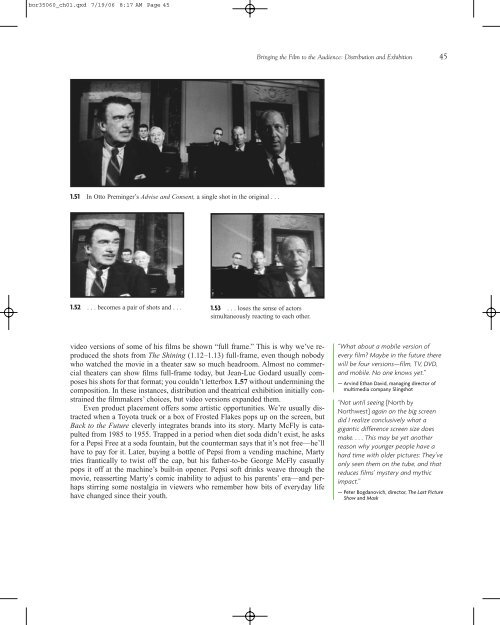FILM ART AND FILMMAKING
FILM ART AND FILMMAKING
FILM ART AND FILMMAKING
You also want an ePaper? Increase the reach of your titles
YUMPU automatically turns print PDFs into web optimized ePapers that Google loves.
or35060_ch01.qxd 7/19/06 8:17 AM Page 45<br />
1.51 In Otto Preminger’s Advise and Consent, a single shot in the original . . .<br />
1.52 . . . becomes a pair of shots and . . . 1.53 . . . loses the sense of actors<br />
simultaneously reacting to each other.<br />
video versions of some of his films be shown “full frame.” This is why we’ve reproduced<br />
the shots from The Shining (1.12–1.13) full-frame, even though nobody<br />
who watched the movie in a theater saw so much headroom. Almost no commercial<br />
theaters can show films full-frame today, but Jean-Luc Godard usually composes<br />
his shots for that format; you couldn’t letterbox 1.57 without undermining the<br />
composition. In these instances, distribution and theatrical exhibition initially constrained<br />
the filmmakers’ choices, but video versions expanded them.<br />
Even product placement offers some artistic opportunities. We’re usually distracted<br />
when a Toyota truck or a box of Frosted Flakes pops up on the screen, but<br />
Back to the Future cleverly integrates brands into its story. Marty McFly is catapulted<br />
from 1985 to 1955. Trapped in a period when diet soda didn’t exist, he asks<br />
for a Pepsi Free at a soda fountain, but the counterman says that it’s not free—he’ll<br />
have to pay for it. Later, buying a bottle of Pepsi from a vending machine, Marty<br />
tries frantically to twist off the cap, but his father-to-be George McFly casually<br />
pops it off at the machine’s built-in opener. Pepsi soft drinks weave through the<br />
movie, reasserting Marty’s comic inability to adjust to his parents’ era—and perhaps<br />
stirring some nostalgia in viewers who remember how bits of everyday life<br />
have changed since their youth.<br />
Bringing the Film to the Audience: Distribution and Exhibition 45<br />
“What about a mobile version of<br />
every film? Maybe in the future there<br />
will be four versions—film, TV, DVD,<br />
and mobile. No one knows yet.”<br />
— Arvind Ethan David, managing director of<br />
multimedia company Slingshot<br />
“Not until seeing [North by<br />
Northwest] again on the big screen<br />
did I realize conclusively what a<br />
gigantic difference screen size does<br />
make. . . . This may be yet another<br />
reason why younger people have a<br />
hard time with older pictures: They’ve<br />
only seen them on the tube, and that<br />
reduces films’ mystery and mythic<br />
impact.”<br />
— Peter Bogdanovich, director, The Last Picture<br />
Show and Mask

















